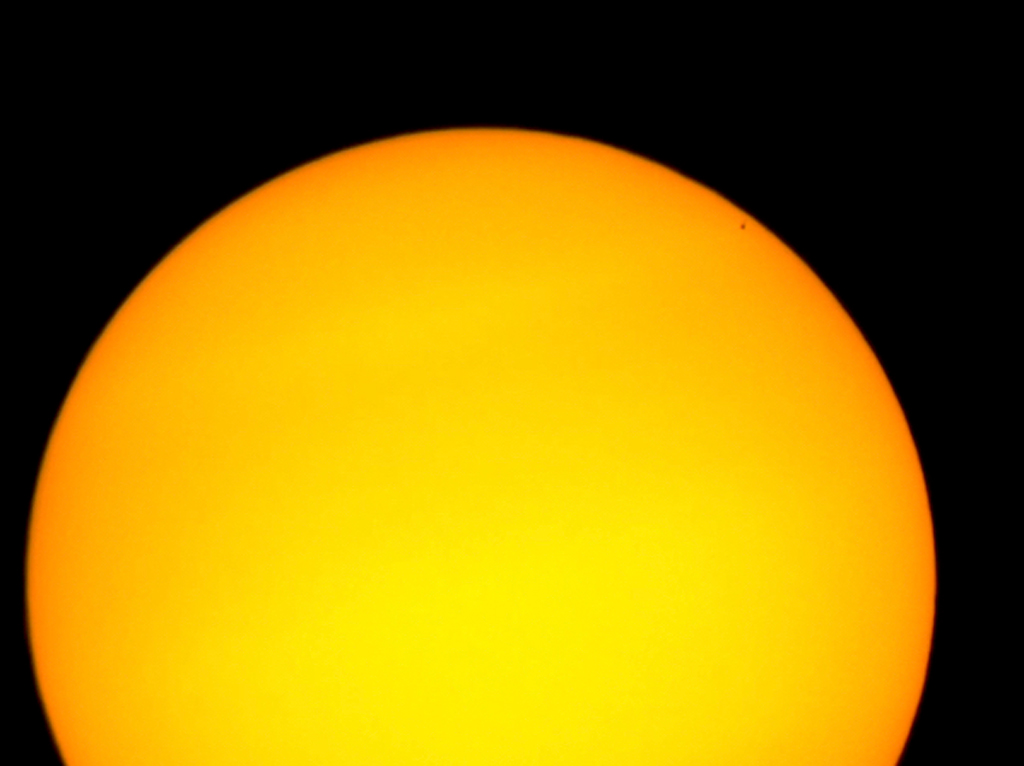
On average, Mercury can be seen transiting (passing across the face of) our Sun only 13 times every century. On November 11, half of the planet from the eastern part of Africa to the west side of the North American continent could see one of these rare events with the right equipment. Despite the fact that Mercury is over 23 million times smaller than the Sun by volume (or 285 times smaller by diameter), an observer on Earth can view the shadow of the planet in a telescope as it appears as a tiny dot moving slowly across the Sun’s disk as the planet orbits the Sun.
SETI Institute has partnered with Unistellar, a company based in France with offices in the Silicon Valley that has designed the eVscope, a robotic, smart, and connected telescope. Unistellar started its beta test recently and several backers of their 2017 Kickstarter have received their eVscope. Initially designed to see faint dark sky objects, scientists and engineers at Unistellar and SETI Institute have been thinking about its use as well to observe the Sun, and this event was the motivation that they needed to make this idea a reality.
You can’t observe the Sun directly with a telescope or binoculars since it is so bright that it will damage your equipment and your eyes. PLEASE DO NOT OBSERVE THE SUN WITHOUT PROPER EQUIPMENT AND EYE PROTECTION! To avoid eye and equipment damage, it is necessary to add a solar filter in front of the instrument to reduce the intensity of the light of the sun. This is also the case with the eVscope, and that’s why Unistellar recommended installing a neutral density filter (such as Mylar) in front of their telescope.
A few days before the event, Dan Peluso, graduate student at the University of Southern Queensland (USQ) and Franck Marchis, one of his supervisors, tested and validated this equipment from San Francisco. Because of the recent poor weather conditions in the Bay Area, the team decided that Dan would attempt to observe the event from the North Bay in Vallejo CA, which was less likely to be under the thick fog of the greater San Francisco area.
On November 11, 2019, the transit began in Europe and Africa, but due to poor weather conditions none of our backers and the Unistellar team in Marseille were able to observe the beginning of the transit. However, one of them located in Reunion Island, a small island east of Madagascar, captured the transit as the Sun was setting on the Indian Ocean. His perseverance during the day despite the rain had paid off and he sent us his picture just at the time when sun was rising in California. Located 6378 km from the first eVscope Mercury transit observer, we were getting ready to take over.
Dan Peluso observed the transit from 7:30 am to 10:04 am PDT, which was approximately from the middle of the event to the end. His setup was relatively simple and he had only recently received an eVscope. In addition to his Unistellar eVscope, he had a cellphone to control it, a mylar solar filter, access to the sky in his backyard, some morning coffee, and a pair of headphones to listen to a pre-prepared music playlist from the same phone controlling the telescope!
This first experiment has confirmed that the small, but mighty, eVscope is the right tool to observe the sun safely, such as a rare planetary transit. In the future, eVscopes may study the activity of the sun in more detail by imaging sunspots on the photospheres. With all observing events with the eVscope, users have the ability to share images instantaneously on social media, and ability that will change how people enjoy the skies and conduct citizen science.
Together with several hundred observers located across three continents (a number estimated from the activity on Twitter with the hashtag #MercuryTransit), the Unistellar beta network has witnessed and recorded this worldwide astronomical event. Peluso put together a neat video as a testimony of this first attempt to observe the sun with our network. In the time lapse video, you can see the tiny dot (Mercury which is 1/3 the size of Earth) moving across the disk of our gigantic sun (100 times the size of Earth); something to remind us that we are not much at the scale of the Universe!
Video
Transit of Mercury YouTube Time Lapse Video by Dan Peluso:
We are, however, the only species that can predict such event and dedicate some of our free time to observe it and grasp the importance of witnessing phenomena resulting from the motion of planets around our sun. That’s what makes us Earthlings.






